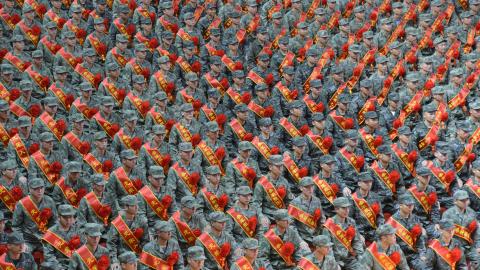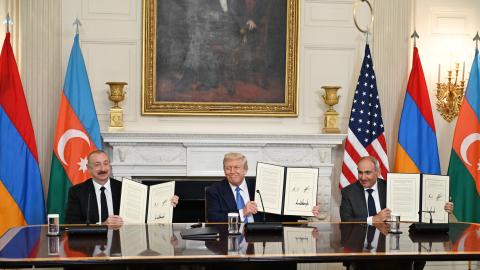The United States is seeking to regain the initiative in Afghanistan, where a radical Islamic insurgency has gained considerable strength over the past year. US President George W. Bush, making his first policy address on the Afghan war since winning re-election in 2004, declared February 15 that the US commitment to Afghanistan remained "strong," backing his words with a request for billions of dollars worth of additional security and economic assistance for Kabul.
Bush also indicated that American and NATO armed forces in Afghanistan would step up military operations against Taliban insurgents. Afghanistan registered a dramatic upsurge in violence in 2006. [For background see the Eurasia Insight archive].
Bush himself described the fighting in 2006 as "the most violent year in Afghanistan since the liberation of the country [in 2001]." Islamic militants appear intent on expanding their armed operations this year, a fact underscored by the storming in early February of Musa Qala, a town in southern Helmand Province, which had been held up as a reconstruction showpiece. [For background see the Eurasia Insight archive].
Instead of the Taliban, it will be the US Army and NATO that will be seizing the initiative this spring, Bush vowed. "The snow is going to melt in the Hindu Kush Mountains, and when it does, we can expect fierce fighting to continue," Bush said. "Our strategy is not to be on the defense, but to go on the offence. This spring there is going to be a new offensive in Afghanistan, and its going to be a NATO offensive."
Bush spoke out on Afghanistan after his administration concluded "a top-to-bottom [strategic] review." The president urged Congress to provide $11.8 billion in additional funding over a two-year period to train and equip Afghan army and police forces, as well as to promote Afghan economic reconstruction projects and to fund counter-narcotics initiatives. "Were going to stay focused on the poppy issue," Bush said.
Bush disparaged the Taliban as an "an enemy that cant stand the thought of somebody being able to live a peaceful life, a life of hope, an optimistic life." At the same time, he admitted that the Taliban insurgency was something "weve got to take seriously."
Earlier this month in Afghanistan, US General Dan McNeil assumed command of the 35,500-strong International Security and Assistance Force (ISAF) in Afghanistan. The turnover from departing British Gen. David Richards occurred as the NATO-led force prepares to counter a new Taliban spring offensive. Gen. McNeil pledged, "We will quit neither post nor mission until the job is done or we are properly relieved."
At the same time, the US Department of Defense has extended the tours of a 3,200-troop 10th Mountain Division brigade in an effort to bolter a theater tactical reserve force for military operations in southern Afghanistan. The lack of an adequate reserve force created additional logistical challenges for American commanders during last years fighting. As a result, the number of American troops in Afghanistan now stands at over 25,000, the highest figure since the start in late 2001 of the US-led blitz to drive the Taliban from power. About 16,000 American forces now fall under NATO command through ISAF, which also includes troop contingents from 36 other countries. The other 9,000 troops US troops in Afghanistan are under American command, engaging primarily in training the Afghan National Army, as well as conducting counterterrorist missions.
The administrations new aid package would allocate $8.6 billion for training and equipping Afghan security forces, with the aim of increasing the size of the army to 70,000, and the national police to over 82,000 by the end of 2008. Experts recognize, however, that many months will elapse before any major improvements become apparent.
In the interim, NATO soldiers will strive to fill the gap, struggling to achieve a balance between fighting, peacekeeping, policing, and rebuilding. American and NATO military commanders believe that coalition forces still fall about 15 percent short of the number of troops needed to fight the Taliban effectively. NATOs new Supreme Commander, US Army Gen. John Craddock, has reportedly requested about 2,000 additional troops as well as additional helicopters. After the United States, Britain provides the largest number of foreign troops (5,200) in support of the Afghan government, followed by Germany (3,000), Canada (2,500) and the Netherlands (2,200).
In addition to the overall troop shortfall, NATO operations have been hampered by "national caveats" that limit the ability of various troop contingents to participate in ISAFs operations. Some of these caveats restrict the locations where their troops can operate; others limit the type of operations in which they can engage. Many are rooted in domestic political considerations back home. For example, France, Germany, Italy and Spain presently are reluctant to deploy their respective troop contingents in areas where they would become engaged in heavy fighting against Islamic militants. Instead, they want their troops primarily to assist in reconstruction and stabilization efforts.
American, British, Canadian, and Dutch forces currently have had to bear the brunt of the fighting against the Taliban, mainly in southern Afghanistan. Hard-pressed coalition ground forces have had to rely increasingly on air strikes, which have resulted in increased civilian casualties, thus threatening to undermine popular support for ISAF and the allied Afghan government under President Hamid Karzai.
In his speech, given at the American Enterprise Institute, a conservative-dominated think tank in Washington, DC, Bush insisted that "allies must lift restrictions on the forces they do provide so NATO commanders have the flexibility they need to defeat the enemy."
In response to the rise of Taliban activity, only Britain and the United States have increased their troop strength in Afghanistan. Other NATO governments have yet to fulfill the force commitments they made last year, let alone volunteer new commitments. France recently withdrew its special forces unit from Afghanistan, while German Defense Minister Franz-Josef Jung has challenged the fundamental assumption that more troops can achieve a military victory, noting that the Soviet military could never defeat the insurgency, despite deploying 100,000 troops in the country.
The timing of the recent American initiatives, revealed on the eve of major meetings of NATOs defense and foreign ministers, suggests that the Bush administration wants to pressure other governments into bolstering their own efforts in Afghanistan. In his speech to the Munich Security Conference on February 11, the new US Secretary of Defense, Robert Gates, said it would be a mark of shame for NATO if it proved unable to mobilize sufficient resources to win the war in Afghanistan: "An alliance consisting of the worlds most prosperous industrialized nations, with over two million people in uniform not even counting the American military should be able to generate the manpower and materiel needed to get the job done in Afghanistan."

















